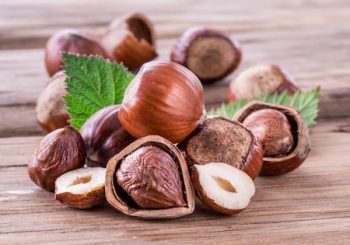By Sayer Ji
Contributing writer for Wake Up World
Nuts are a nutrient-dense food that contain healthy fats, protein, fiber, minerals and phenolic compounds. They are thought to offer wide-ranging cardiovascular and metabolic benefits and can be readily integrated into a balanced diet.[i]
The hazelnut, which comes from the Corylus tree of the Betulaceae family, offers a sweet flavor and the flexibility of being eaten raw, roasted or as a paste in ground form.
[pro_ad_display_adzone id=”110028″]
It’s considered an excellent anti-inflammatory and hypolipidemic treat, being the second richest source of monounsaturated fatty acids (MUFAs) among nuts and being chock full of vitamin E, magnesium, copper, selenium, L-arginine, folate, fiber and polyphenols, to name a few.[ii] Here are five evidence-based benefits of hazelnuts.
1. Antioxidant Protection
Hazelnuts have one of the highest oxygen radical absorbance capacity (ORAC) scores of any nut, signifying outstanding levels of antioxidants.[iii] These chemicals protect the body from oxidative stress, which can damage cells, accelerate aging and promote disease.[iv],[v]
As testament to their antioxidant prowess, a hazelnut-enriched diet modulates oxidative stress and inflammatory gene expression without causing weight gain.[vi] Compounds of the tiny, mighty nut have been found to have antioxidant and antimicrobial effects.[vii]
Hazelnuts also contain the antioxidant vitamin E, which some studies indicate may help shield the body from cell damage linked to cancer.[viii]
2. Antiobesity Strategy
Proteins derived from hazelnuts are an excellent source of bioactive peptides. A 2019 study purified and identified antiobesity peptides from the nut, finding that the novel synthetic pentapeptide had potential antiobesity effects and may help combat metabolic conditions.[ix]
In a European study involving over 370,000 men and women ranging from 25 to 70 years old, higher intake of nuts was associated with reduced weight gain along with a lower risk of becoming obese or overweight.[x]
3. Improved Cardiovascular Health
The MUFAs and antioxidants in hazelnuts have been tied to a reduced risk of cardiovascular disease.[xi] In an intervention diet lasting up to 84 days with a dosage of hazelnuts ranging from 29 to 69 grams a day, it emerged that a hazelnut-enriched diet can decrease LDL cholesterol and total cholesterol, without substantially changing HDL cholesterol, triglycerides and body mass index (BMI).[xii]
According to separate research, a high-fat, high-MUFA hazelnut diet proved superior to a low-fat diet in terms of creating favorable changes in lipid profiles, therefore positively affecting coronary heart disease risk in the subjects.[xiii]
The high fatty acid content as well as fiber, antioxidants, potassium and magnesium, in the nuts also seemed to help normalize blood pressure levels.[xiv] In a randomized study, the combination of hazelnut and cocoa acted in a synergistic and protective way on the cardiovascular system.[xv]
4. Lower Blood Sugar Levels
Largely due to their micro and macronutrient profiles, nuts are believed to help control blood glucose levels.[xvi] They are low in available carbs, offer a healthy fatty acid profile and are high in fiber, plant protein and magnesium. In a study that combined hazelnuts with walnuts and almonds for metabolic syndrome patients, the results also reflected reduced fasting insulin levels.[xvii]
5. Potential Use Against Cancer
The high concentration of antioxidants, vitamins and minerals along with other nutrients in hazelnuts may also give the nut some anticancer action.
In a study, the nuts’ shell extract provided antioxidant effects and cytotoxic activity against human cancer cell lines.[xviii] “The cytotoxic activity relies on the presence of the neolignans (balanophonin), and phenol derivatives (gallic acid), showing a pro-apoptotic effect on the tested cell lines,” the researchers wrote.
Results from a separate study suggested a potential use of hazelnut extracts against cervical cancer, hepatocarcinoma and breast cancer.[xix]
Learn more about hazelnuts from study abstracts on the GreenMedInfo.com database. Incorporate these nuts into your diet as a snack or a component of many different dishes, enjoying them raw, roasted, sliced, ground or even whole. Peeled hazelnuts can also be turned into flour for healthy baking or as a nutrient-filled spread.
References:
[i] Ros E “Health Benefits of Nut Consumption” Nutrients. 2010 Jul; 2(7): 652-682. Epub 2010 Jun 24.
[ii] Di Renzo L et al “A Hazelnut-Enriched Diet Modulates Oxidative Stress and Inflammation Gene Expression without Weight Gain” Oxid Med Cell Longev. 2019; 2019: 4683723. Epub 2019 Jul 4.
[iii] Phytochemicals.info https://www.phytochemicals.info/list-orac-values.php
[iv] Sinha N et al “Oxidative stress and antioxidants in hypertension-a current review” Curr Hypertens Rev. 2015;11(2):132-42.
[v] Frijhoff J et al “Clinical Relevance of Biomarkers of Oxidative Stress” Antioxid Redox Signal. 2015 Nov 10;23(14):1144-70. Epub 2015 Oct 26.
[vi] Di Renzo L et al “A Hazelnut-Enriched Diet Modulates Oxidative Stress and Inflammation Gene Expression without Weight Gain” Oxid Med Cell Longev. 2019; 2019: 4683723. Epub 2019 Jul 4.
[vii] Cerulli A et al “Cyclic Diarylheptanoids from Corylus avellana Green Leafy Covers: Determination of Their Absolute Configurations and Evaluation of Their Antioxidant and Antimicrobial Activities” J Nat Prod. 2017 Jun 23 ;80(6):1703-1713. Epub 2017 May 18.
[viii] Algahtani S et al “Vitamin E Transporters in Cancer Therapy” AAPS J. 2015 Mar; 17(2): 313-322. Epub 2014 Dec 3.
[ix] Wang J et al “Novel anti-obesity peptide (RLLPH) derived from hazelnut protein hydrolysates inhibits adipogenesis in 3T3-L1 adipocytes by regulating adipogenic transcription factors and adenosine monophosphate-activated protein kinase (AMPK) activation” J Biosci Bioeng. 2019 Oct 17. Epub 2019 Oct 17.
[x] Freisling H et al “Nut intake and 5-year changes in body weight and obesity risk in adults: results from the EPIC-PANACEA study” Eur J Nutr. 2017 Jul 21; 57:2399-2408.
[xi] Perna S et al “Effects of Hazelnut Consumption on Blood Lipids and Body Weight: A Systematic Review and Bayesian Meta-Analysis” Nutrients. 2016 Nov 25 ;8(12). Epub 2016 Nov 25.
[xii] Perna S et al “Effects of Hazelnut Consumption on Blood Lipids and Body Weight: A Systematic Review and Bayesian Meta-Analysis” Nutrients. 2016 Nov 25 ;8(12). Epub 2016 Nov 25.
[xiii] Mercanligil S et al “Effects of hazelnut-enriched diet on plasma cholesterol and lipoprotein profiles in hypercholesterolemic adult men” Nutr J. 2009 Jul 22;8(1):34.
[xiv] Mohammadifard N et al “The effect of tree nut, peanut, and soy nut consumption on blood pressure: a systematic review and meta-analysis of randomized controlled clinical trials” Am J Clin Nutr. 2015 May;101(5):966-82. Epub 2015 Mar 25.
[xv] Adamo M et al “Effects of hazelnuts and cocoa on vascular reactivity in healthy subjects: a randomised study” Int J Food Sci Nutr. 2017 Jul 9:1-12. Epub 2017 Jul 9.
[xvi] Kendall C et al “Health benefits of nuts in prevention and management of diabetes” Asia Pac J Clin Nutr. 2010;19(1):110-6.
[xvii] Casas-Agustench P et al “Effects of one serving of mixed nuts on serum lipids, insulin resistance and inflammatory markers in patients with the metabolic syndrome” Nutr Metab Cardiovasc Dis. 2011 Feb;21(2):126-35. doi: Epub 2009 Dec 22.
[xviii] Esposito T et al “Hazelnut (Corylus avellana L.) Shells Extract: Phenolic Composition, Antioxidant Effect and Cytotoxic Activity on Human Cancer Cell Lines” Int J Mol Sci. 2017 Feb 13 ;18(2). Epub 2017 Feb 13.
[xix] Gallego A et al “Viability-reducing activity of Coryllus avellana L. extracts against human cancer cell lines” Biomed Pharmacother. 2017 May ;89:565-572. Epub 2017 Mar 1.
Recommended Articles by Sayer Ji:
- The Power and Mystery of Melanin Explained
- Cell Phone Induced Bodily Harm: How the Bees Can Help
- The Spice That Prevents Fluoride Destroying Your Brain
- How to Clean Your Arteries with One Simple Fruit
- 7 Healing Uses for Lavender Essential Oil
- From Table to Tomb: Cumin’s Health Benefits Rediscovered
- Why You Should Ditch Sugar in Favour of Honey
- The Love Affair Between Saffron and Humanity: As Ancient as Time Itself
- Why Walnut Resembles the Brain It Nourishes
- Magnesium Puts Psychiatric Drugs to Shame for Depression
About the author:
Sayer Ji is the founder of Greenmedinfo.com, a reviewer at the International Journal of Human Nutrition and Functional Medicine, Co-founder and CEO of Systome Biomed, Vice Chairman of the Board of the National Health Federation, and Steering Committee Member of the Global Non-GMO Foundation.
© 2020 GreenMedInfo LLC. This work is reproduced and distributed with the permission of GreenMedInfo LLC. Want to learn more from GreenMedInfo? Sign up for their newsletter here.
[pro_ad_display_adzone id=”110027″]









